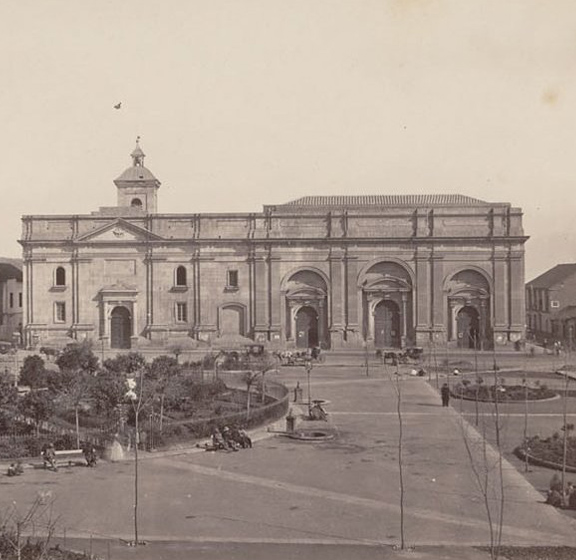
Fragmento de fotografía de William L. Olliver, Catedral de Santiago 1867.
The history of the Cathedral is, without a doubt, controversial. The little and almost no research and documentation regarding the art history in Chile during the Colony, and the absence of discussions regarding the topic, make difficult providing accuracy on the data that refers to the Cathedral’s building history. Some authors refer to the fact that there were five stages, another author states there were seven and others mention only four stages until reaching the Cathedral that exists today. Some, simply, avoid the number of times that the Cathedral had to be rebuilt or remodeled, due to damages caused by fire, sacking and a number of earthquakes. Earthquakes are the fate of the Cathedral and incredibly, it is also its attraction for tourists and, certainly, a challenge for architects and builders, who have faced the force of nature in each stage of their proposals.Even so, it is known that the Cathedral was the last church planned by Pedro de Valdivia, the founder of Santiago, on February 12, 1541, located on the west side of the Plaza Mayor (currently the Arms Square). This very first modest construction was completely destroyed after the indigenous uprising headed by Michimalonco (cacique that fiercely opposed the Spanish conquest) on September 11 of that same year.
Afterwards, the Cathedral goes through a series of both natural and man-produced disasters, being built numerous times with differences in terms of size, direction and materials, at the mercy of the bishops and architects of the day and according to the needs that arose from the community until reaching the construction there is today.
It is worth noting that the Cathedral was originally a humble chapel located in the Plaza Mayor (Main Square) and it was not until 1561 when Pope Píus IV, on erecting the Santiago Bishopric consecrated the building as the Cathedral. The erection ceremony of the diocese and, therefore, the building of the Cathedral were carried out in July 1563. These facts, therefore, mark the Cathedra’s beginning and determine the history of Chilean society, headed by the church for many years.
The Cathedral currently located in the Arms Square goes back to 1745 when Bishop González Marmolejo entrusted the work to the constructor Matías Vásquez de Acuña, whose drawings were executed by the Bavarian architects Pedro Vogl and Juan Hagen. The most important aspect behind this building was its new location facing from east to west. Later it suffered several damages after the earthquake and fire occurring years later.
In 1780, with the support of the Bishop Manuel de Alday, the Italian architect Joaquín Toesca takes on the construction, and works on the existing layout introducing all his style to the new Cathedral. Toesca died without seeing the finished work and Juan José de Goycoolea, as Vice-Chancellor, continued with the construction of the building strictly and rigorously following the drawings drafted by his master.
In 1899, Archbishop Mariano Casanova contracted the Italian Architect Ignazio Cremonesi to perform the beautification of the Cathedral, in order to “dignify” the state which was at that time, which was austere and somber. Cremonesi radically transformed the Cathedral and some of his excesses were corrected through time.